
Proteostasis Therapeutics, Inc. (PTI) Q3 2017 Investor Presentation Exhibit 99.1
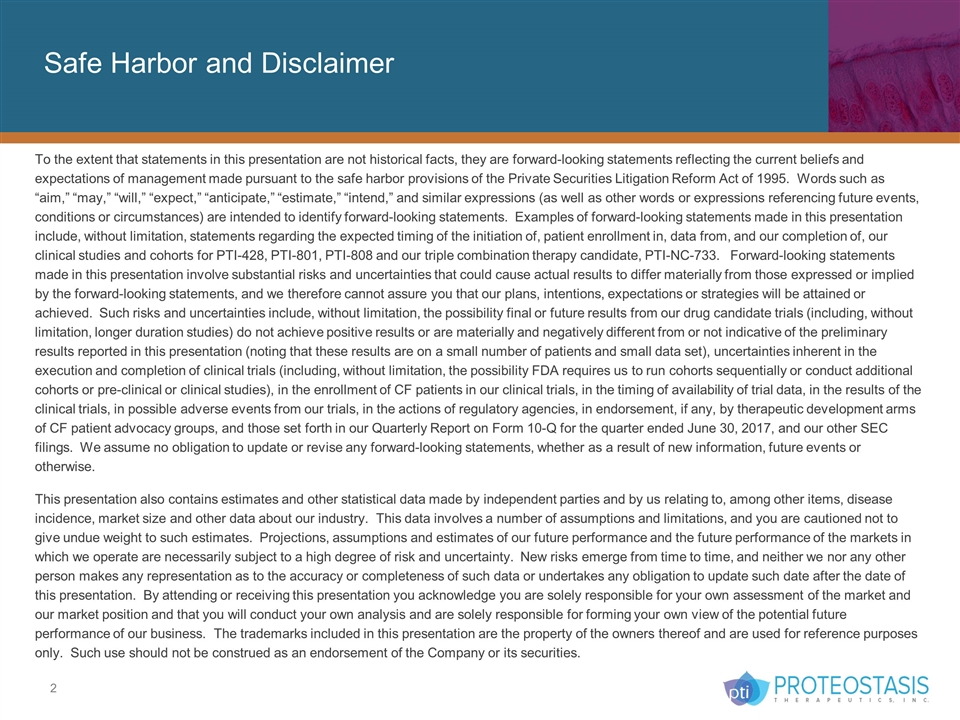
Safe Harbor and Disclaimer To the extent that statements in this presentation are not historical facts, they are forward-looking statements reflecting the current beliefs and expectations of management made pursuant to the safe harbor provisions of the Private Securities Litigation Reform Act of 1995. Words such as “aim,” “may,” “will,” “expect,” “anticipate,” “estimate,” “intend,” and similar expressions (as well as other words or expressions referencing future events, conditions or circumstances) are intended to identify forward-looking statements. Examples of forward-looking statements made in this presentation include, without limitation, statements regarding the expected timing of the initiation of, patient enrollment in, data from, and our completion of, our clinical studies and cohorts for PTI-428, PTI-801, PTI-808 and our triple combination therapy candidate, PTI-NC-733. Forward-looking statements made in this presentation involve substantial risks and uncertainties that could cause actual results to differ materially from those expressed or implied by the forward-looking statements, and we therefore cannot assure you that our plans, intentions, expectations or strategies will be attained or achieved. Such risks and uncertainties include, without limitation, the possibility final or future results from our drug candidate trials (including, without limitation, longer duration studies) do not achieve positive results or are materially and negatively different from or not indicative of the preliminary results reported in this presentation (noting that these results are on a small number of patients and small data set), uncertainties inherent in the execution and completion of clinical trials (including, without limitation, the possibility FDA requires us to run cohorts sequentially or conduct additional cohorts or pre-clinical or clinical studies), in the enrollment of CF patients in our clinical trials, in the timing of availability of trial data, in the results of the clinical trials, in possible adverse events from our trials, in the actions of regulatory agencies, in endorsement, if any, by therapeutic development arms of CF patient advocacy groups, and those set forth in our Quarterly Report on Form 10-Q for the quarter ended June 30, 2017, and our other SEC filings. We assume no obligation to update or revise any forward-looking statements, whether as a result of new information, future events or otherwise. This presentation also contains estimates and other statistical data made by independent parties and by us relating to, among other items, disease incidence, market size and other data about our industry. This data involves a number of assumptions and limitations, and you are cautioned not to give undue weight to such estimates. Projections, assumptions and estimates of our future performance and the future performance of the markets in which we operate are necessarily subject to a high degree of risk and uncertainty. New risks emerge from time to time, and neither we nor any other person makes any representation as to the accuracy or completeness of such data or undertakes any obligation to update such date after the date of this presentation. By attending or receiving this presentation you acknowledge you are solely responsible for your own assessment of the market and our market position and that you will conduct your own analysis and are solely responsible for forming your own view of the potential future performance of our business. The trademarks included in this presentation are the property of the owners thereof and are used for reference purposes only. Such use should not be construed as an endorsement of the Company or its securities.
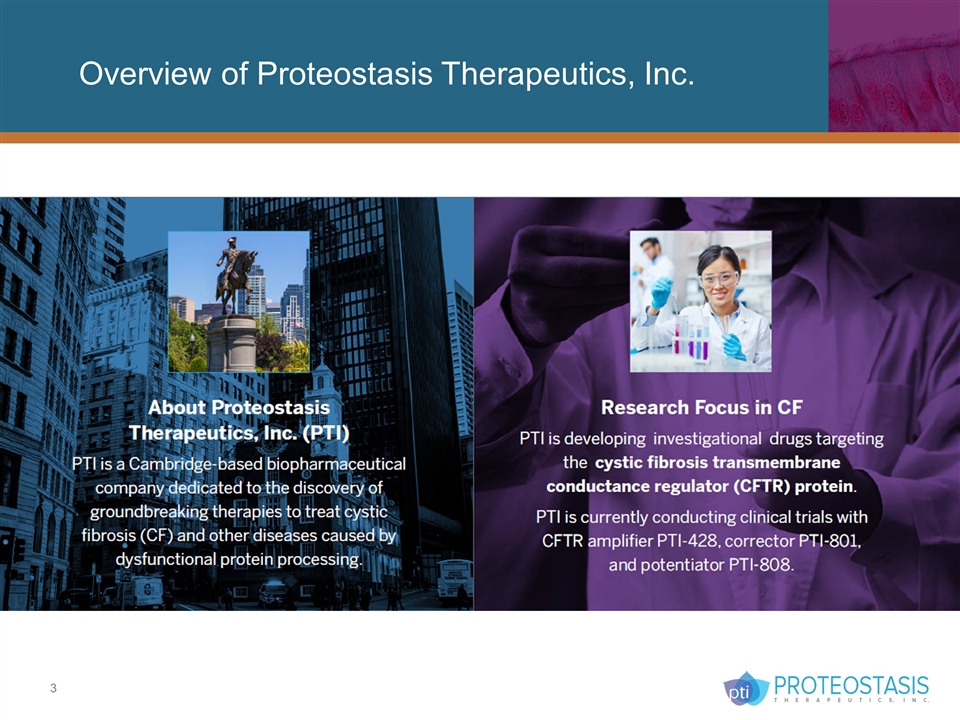
Overview of Proteostasis Therapeutics, Inc.
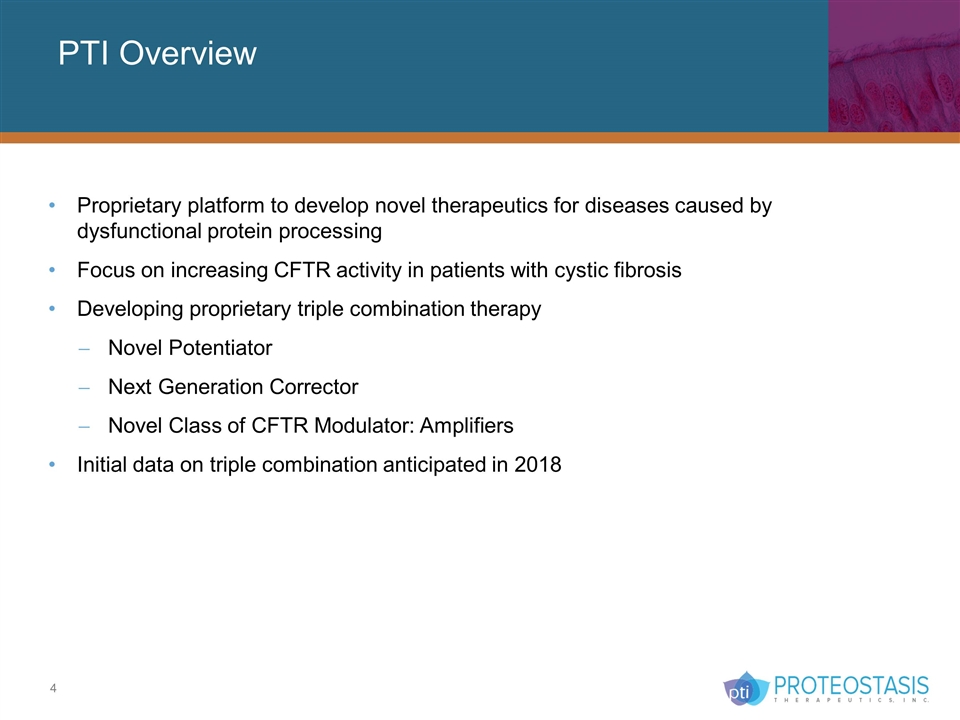
PTI Overview Proprietary platform to develop novel therapeutics for diseases caused by dysfunctional protein processing Focus on increasing CFTR activity in patients with cystic fibrosis Developing proprietary triple combination therapy Novel Potentiator Next Generation Corrector Novel Class of CFTR Modulator: Amplifiers Initial data on triple combination anticipated in 2018
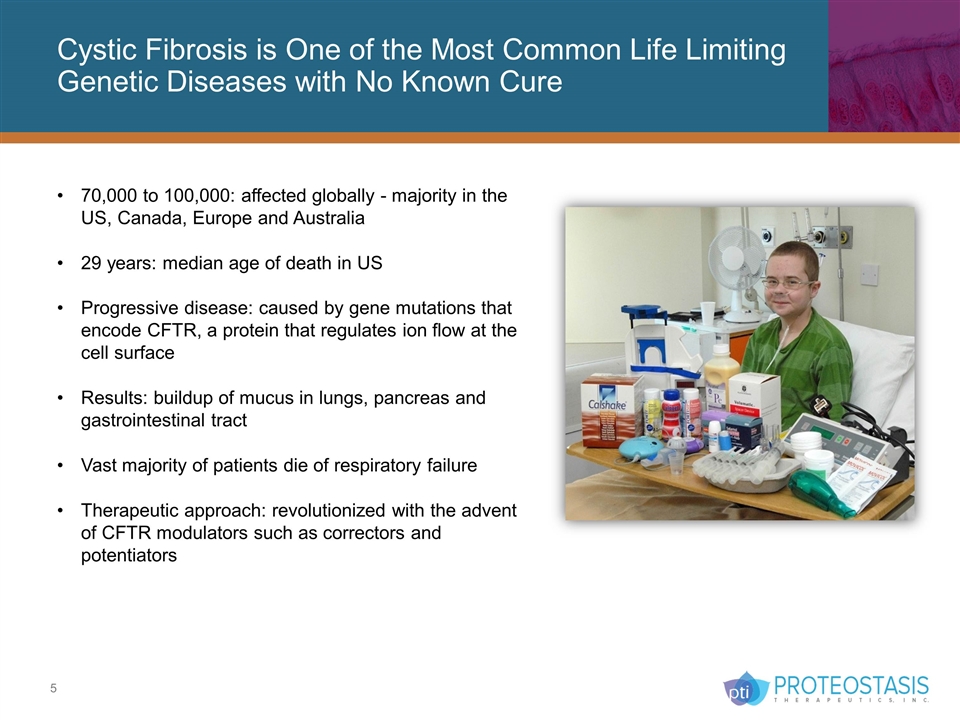
Cystic Fibrosis is One of the Most Common Life Limiting Genetic Diseases with No Known Cure 70,000 to 100,000: affected globally - majority in the US, Canada, Europe and Australia 29 years: median age of death in US Progressive disease: caused by gene mutations that encode CFTR, a protein that regulates ion flow at the cell surface Results: buildup of mucus in lungs, pancreas and gastrointestinal tract Vast majority of patients die of respiratory failure Therapeutic approach: revolutionized with the advent of CFTR modulators such as correctors and potentiators
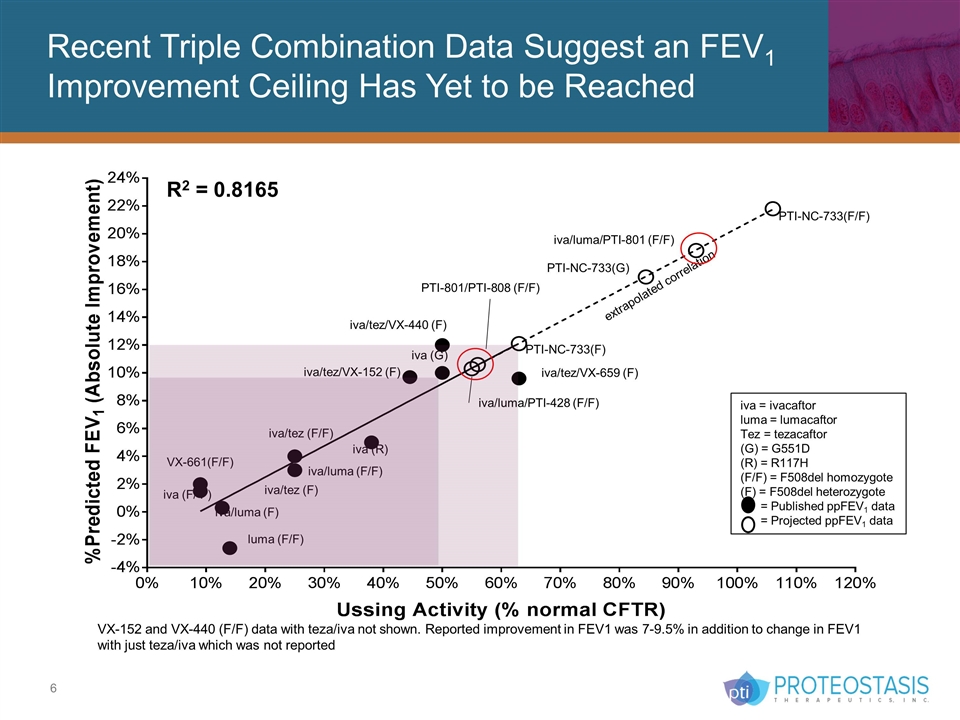
Recent Triple Combination Data Suggest an FEV1 Improvement Ceiling Has Yet to be Reached VX-152 and VX-440 (F/F) data with teza/iva not shown. Reported improvement in FEV1 was 7-9.5% in addition to change in FEV1 with just teza/iva which was not reported R2 = 0.8165 iva = ivacaftor luma = lumacaftor Tez = tezacaftor (G) = G551D (R) = R117H (F/F) = F508del homozygote (F) = F508del heterozygote = Published ppFEV1 data = Projected ppFEV1 data iva (G) iva/luma (F/F) VX-661(F/F) iva (F/ F) luma (F/F) iva (R) iva/luma (F) PTI-NC-733(F/F) extrapolated correlation iva/luma/PTI-428 (F/F) iva/tez/VX-152 (F) PTI-NC-733(G) PTI-801/PTI-808 (F/F) iva/luma/PTI-801 (F/F) iva/tez (F) iva/tez/VX-659 (F) iva/tez/VX-440 (F) PTI-NC-733(F) iva/tez (F/F)
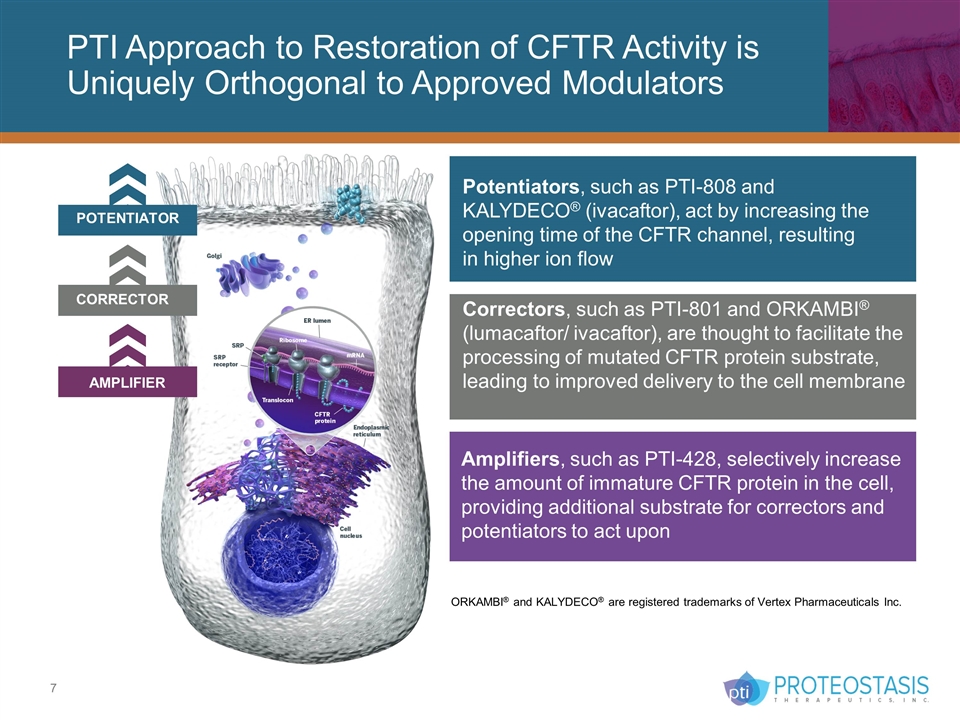
CORRECTOR PTI Approach to Restoration of CFTR Activity is Uniquely Orthogonal to Approved Modulators Amplifiers, such as PTI-428, selectively increase the amount of immature CFTR protein in the cell, providing additional substrate for correctors and potentiators to act upon Potentiators, such as PTI-808 and KALYDECO® (ivacaftor), act by increasing the opening time of the CFTR channel, resulting in higher ion flow Correctors, such as PTI-801 and ORKAMBI® (lumacaftor/ ivacaftor), are thought to facilitate the processing of mutated CFTR protein substrate, leading to improved delivery to the cell membrane POTENTIATOR AMPLIFIER ORKAMBI® and KALYDECO® are registered trademarks of Vertex Pharmaceuticals Inc.
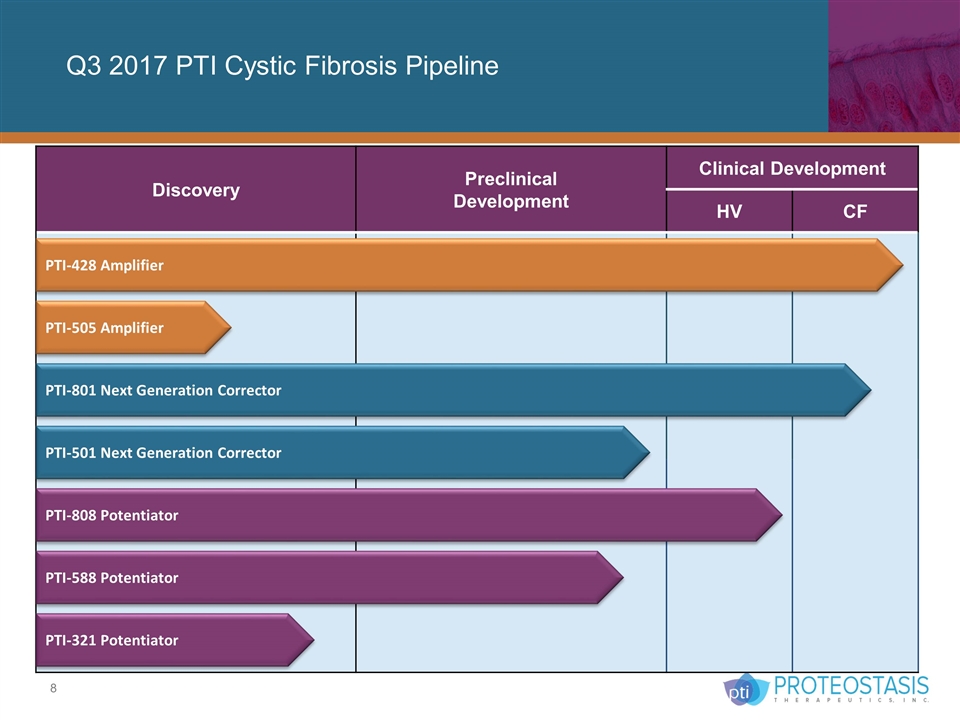
Q3 2017 PTI Cystic Fibrosis Pipeline Discovery Preclinical Development Clinical Development HV CF PTI-428 Amplifier PTI-505 Amplifier PTI-801 Next Generation Corrector PTI-501 Next Generation Corrector PTI-808 Potentiator PTI-588 Potentiator PTI-321 Potentiator
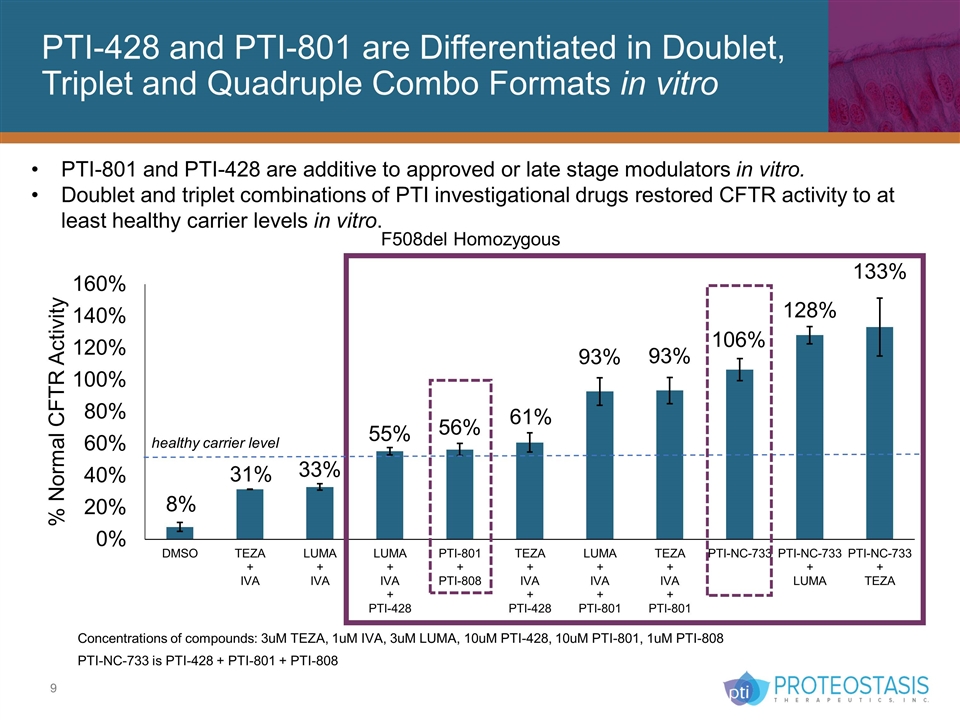
PTI-428 and PTI-801 are Differentiated in Doublet, Triplet and Quadruple Combo Formats in vitro Concentrations of compounds: 3uM TEZA, 1uM IVA, 3uM LUMA, 10uM PTI-428, 10uM PTI-801, 1uM PTI-808 PTI-NC-733 is PTI-428 + PTI-801 + PTI-808 F508del Homozygous healthy carrier level PTI-801 and PTI-428 are additive to approved or late stage modulators in vitro. Doublet and triplet combinations of PTI investigational drugs restored CFTR activity to at least healthy carrier levels in vitro.
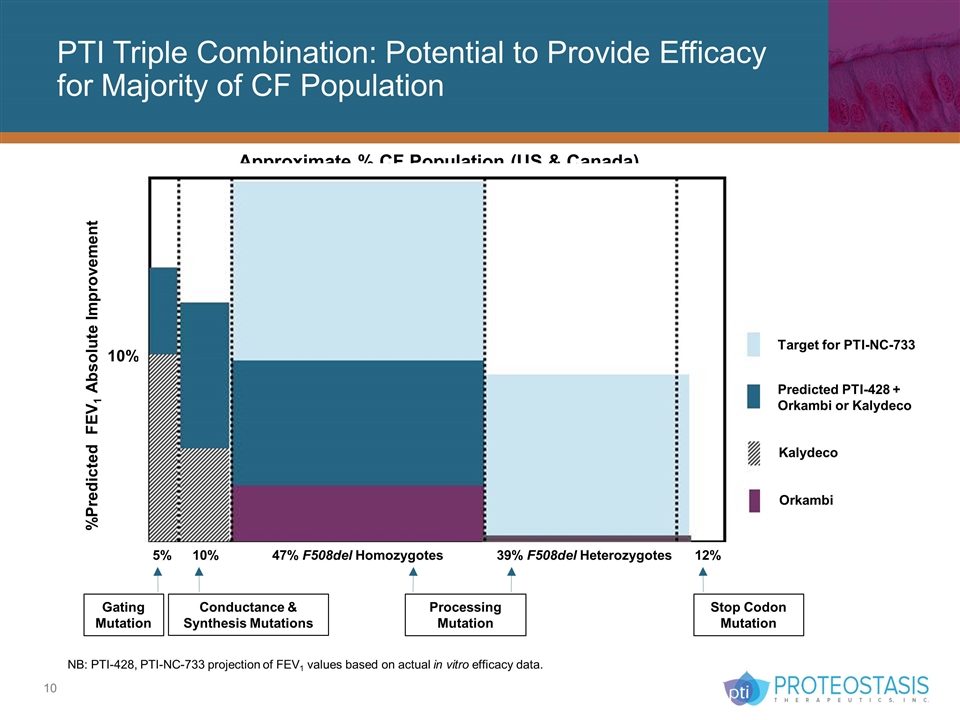
39% F508del Heterozygotes 10% 47% F508del Homozygotes 5% 10% 12% Target for PTI-NC-733 Gating Mutation Conductance & Synthesis Mutations Stop Codon Mutation Processing Mutation Approximate % CF Population (US & Canada) Predicted PTI-428 + Orkambi or Kalydeco %Predicted FEV1 Absolute Improvement Orkambi Kalydeco PTI Triple Combination: Potential to Provide Efficacy for Majority of CF Population NB: PTI-428, PTI-NC-733 projection of FEV1 values based on actual in vitro efficacy data.
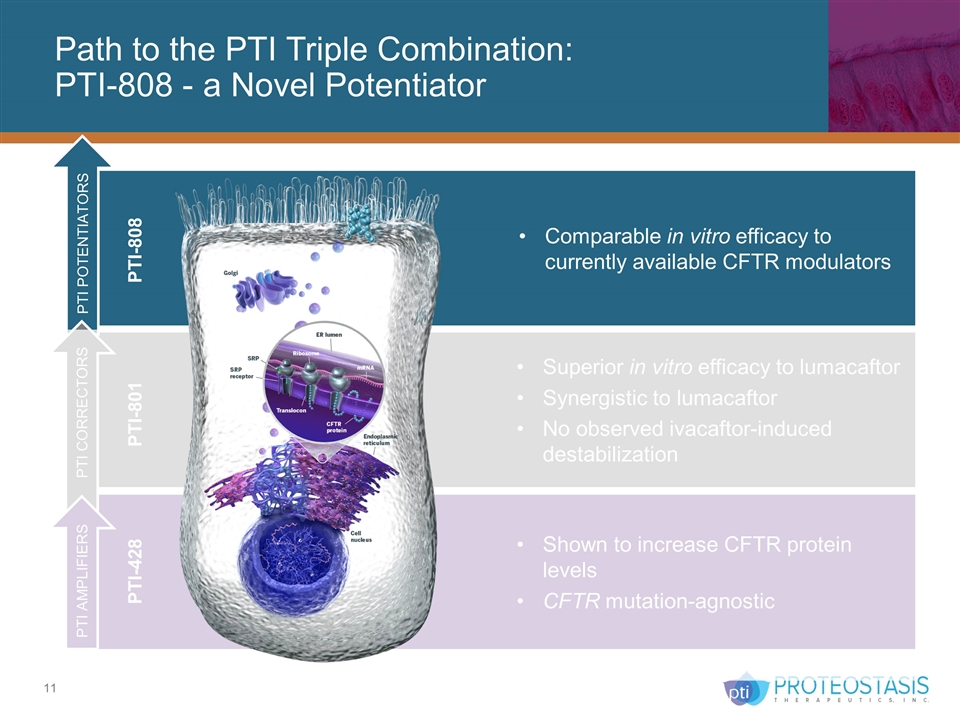
Path to the PTI Triple Combination: PTI-808 - a Novel Potentiator Shown to increase CFTR protein levels CFTR mutation-agnostic PTI POTENTIATORS PTI CORRECTORS PTI AMPLIFIERS PTI-801 PTI-428 PTI-808 Comparable in vitro efficacy to currently available CFTR modulators Superior in vitro efficacy to lumacaftor Synergistic to lumacaftor No observed ivacaftor-induced destabilization
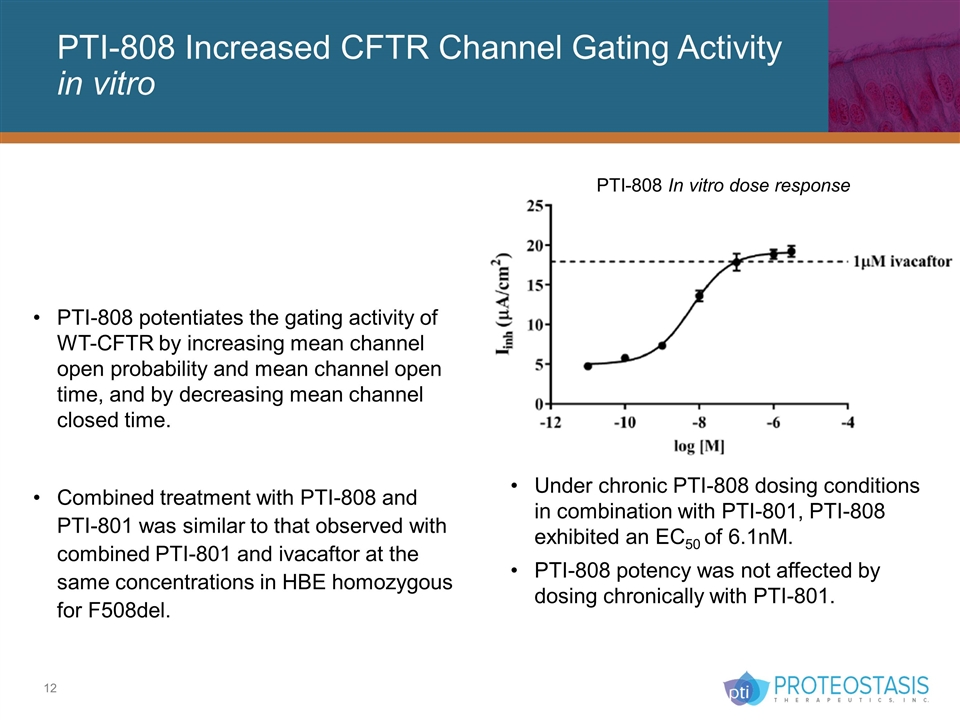
PTI-808 Increased CFTR Channel Gating Activity in vitro PTI-808 potentiates the gating activity of WT-CFTR by increasing mean channel open probability and mean channel open time, and by decreasing mean channel closed time. Combined treatment with PTI-808 and PTI-801 was similar to that observed with combined PTI-801 and ivacaftor at the same concentrations in HBE homozygous for F508del. Under chronic PTI-808 dosing conditions in combination with PTI-801, PTI-808 exhibited an EC50 of 6.1nM. PTI-808 potency was not affected by dosing chronically with PTI-801. PTI-808 In vitro dose response
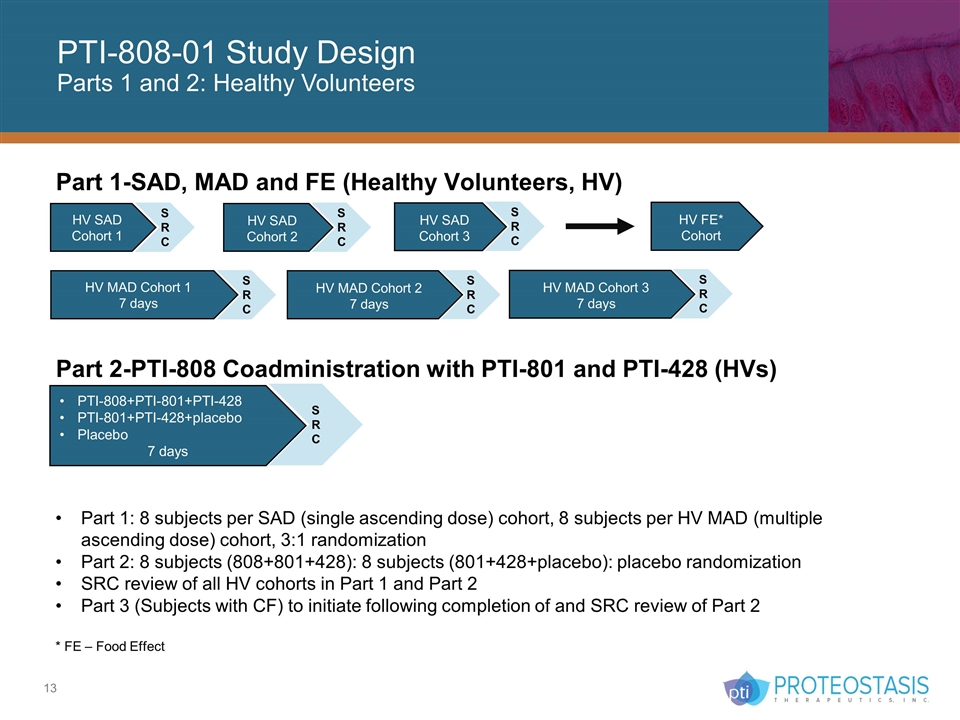
SRC SRC HV SAD Cohort 3 Part 1-SAD, MAD and FE (Healthy Volunteers, HV) HV SAD Cohort 1 HV SAD Cohort 2 Part 1: 8 subjects per SAD (single ascending dose) cohort, 8 subjects per HV MAD (multiple ascending dose) cohort, 3:1 randomization Part 2: 8 subjects (808+801+428): 8 subjects (801+428+placebo): placebo randomization SRC review of all HV cohorts in Part 1 and Part 2 Part 3 (Subjects with CF) to initiate following completion of and SRC review of Part 2 * FE – Food Effect SRC SRC Part 2-PTI-808 Coadministration with PTI-801 and PTI-428 (HVs) PTI-808+PTI-801+PTI-428 PTI-801+PTI-428+placebo Placebo 7 days SRC SRC HV MAD Cohort 3 7 days HV MAD Cohort 1 7 days HV MAD Cohort 2 7 days SRC HV FE* Cohort PTI-808-01 Study Design Parts 1 and 2: Healthy Volunteers
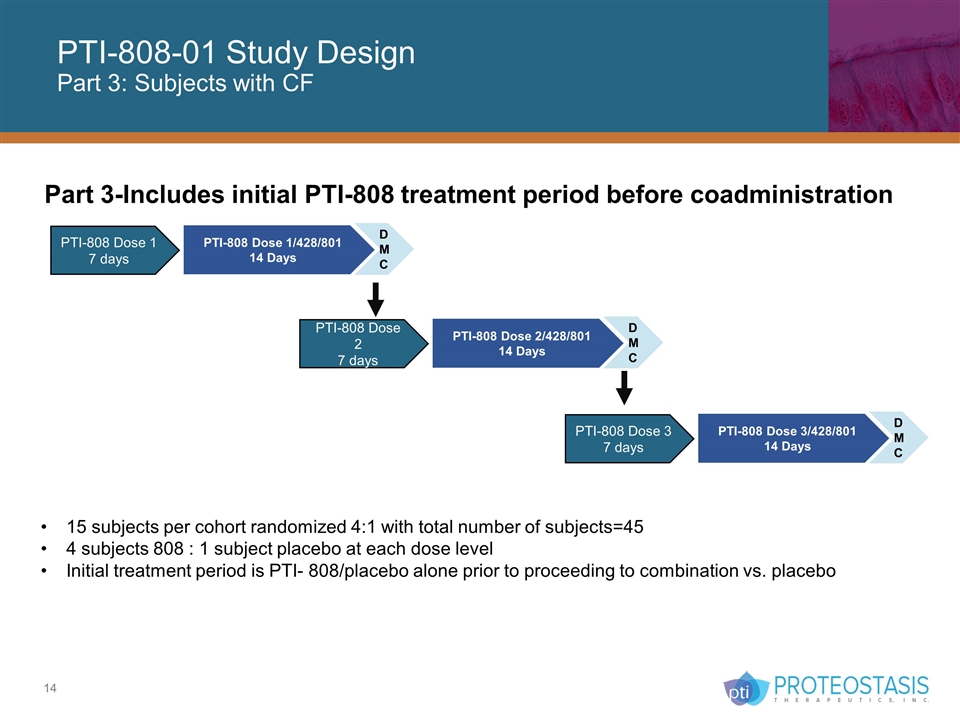
Part 3-Includes initial PTI-808 treatment period before coadministration PTI-808 Dose 1/428/801 14 Days 15 subjects per cohort randomized 4:1 with total number of subjects=45 4 subjects 808 : 1 subject placebo at each dose level Initial treatment period is PTI- 808/placebo alone prior to proceeding to combination vs. placebo DMC PTI-808 Dose 1 7 days PTI-808 Dose 2/428/801 14 Days DMC PTI-808 Dose 2 7 days PTI-808 Dose 3/428/801 14 Days DMC PTI-808 Dose 3 7 days PTI-808-01 Study Design Part 3: Subjects with CF
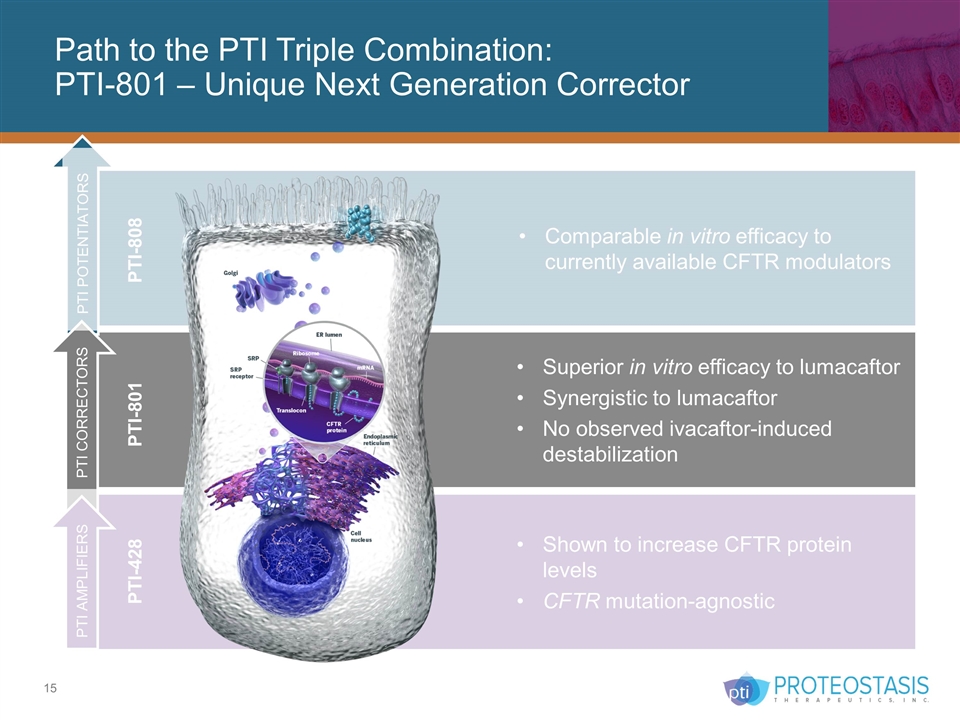
Path to the PTI Triple Combination: PTI-801 – Unique Next Generation Corrector Shown to increase CFTR protein levels CFTR mutation-agnostic PTI POTENTIATORS PTI CORRECTORS PTI AMPLIFIERS PTI-801 PTI-428 PTI-808 Comparable in vitro efficacy to currently available CFTR modulators Superior in vitro efficacy to lumacaftor Synergistic to lumacaftor No observed ivacaftor-induced destabilization
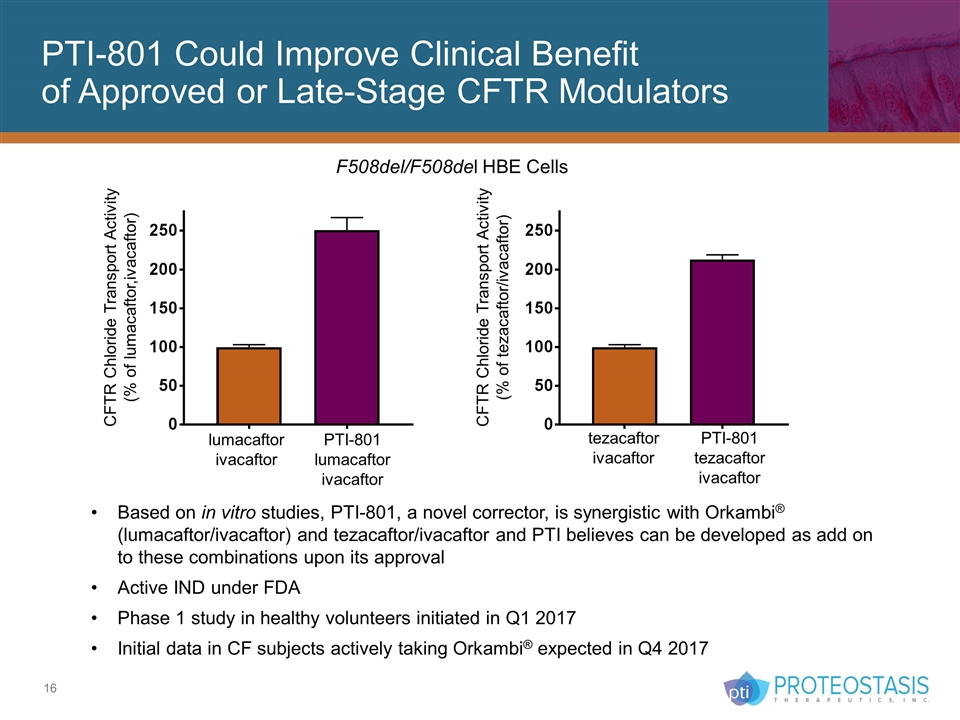
PTI-801 Could Improve Clinical Benefit of Approved or Late-Stage CFTR Modulators lumacaftor ivacaftor PTI-801 lumacaftor ivacaftor tezacaftor ivacaftor PTI-801 tezacaftor ivacaftor CFTR Chloride Transport Activity (% of lumacaftor,ivacaftor) CFTR Chloride Transport Activity (% of tezacaftor/ivacaftor) F508del/F508del HBE Cells Based on in vitro studies, PTI-801, a novel corrector, is synergistic with Orkambi® (lumacaftor/ivacaftor) and tezacaftor/ivacaftor and PTI believes can be developed as add on to these combinations upon its approval Active IND under FDA Phase 1 study in healthy volunteers initiated in Q1 2017 Initial data in CF subjects actively taking Orkambi® expected in Q4 2017
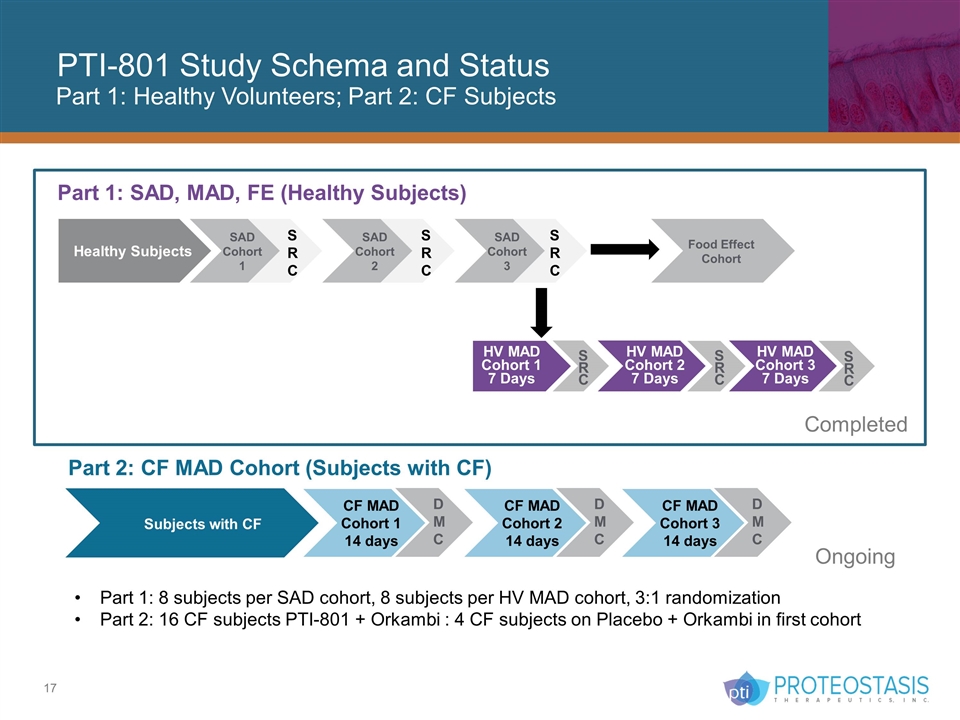
PTI-801 Study Schema and Status DMC Subjects with CF CF MAD Cohort 1 14 days DMC CF MAD Cohort 2 14 days DMC CF MAD Cohort 3 14 days Part 2: CF MAD Cohort (Subjects with CF) Part 1: SAD, MAD, FE (Healthy Subjects) SAD Cohort 1 Healthy Subjects SRC SAD Cohort 2 SRC SAD Cohort 3 SRC Food Effect Cohort HV MAD Cohort 1 7 Days HV MAD Cohort 2 7 Days SRC SRC HV MAD Cohort 3 7 Days SRC Part 1: 8 subjects per SAD cohort, 8 subjects per HV MAD cohort, 3:1 randomization Part 2: 16 CF subjects PTI-801 + Orkambi : 4 CF subjects on Placebo + Orkambi in first cohort Part 1: Healthy Volunteers; Part 2: CF Subjects Completed Ongoing
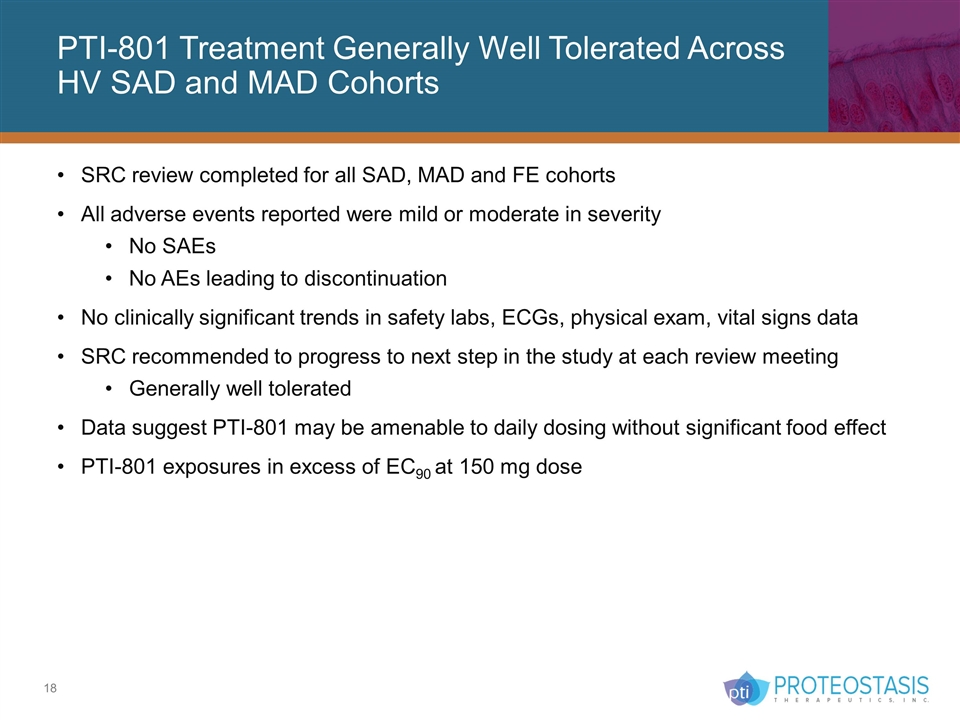
PTI-801 Treatment Generally Well Tolerated Across HV SAD and MAD Cohorts SRC review completed for all SAD, MAD and FE cohorts All adverse events reported were mild or moderate in severity No SAEs No AEs leading to discontinuation No clinically significant trends in safety labs, ECGs, physical exam, vital signs data SRC recommended to progress to next step in the study at each review meeting Generally well tolerated Data suggest PTI-801 may be amenable to daily dosing without significant food effect PTI-801 exposures in excess of EC90 at 150 mg dose

Path to the PTI Triple Combination: PTI-428 – Amplifier, a First-in-Class Novel CFTR Modulator Shown to increase CFTR protein levels CFTR mutation-agnostic PTI POTENTIATORS PTI CORRECTORS PTI AMPLIFIERS PTI-801 PTI-428 PTI-808 Comparable in vitro efficacy to currently available CFTR modulators Superior in vitro efficacy to lumacaftor Synergistic to lumacaftor No observed ivacaftor-induced destabilization
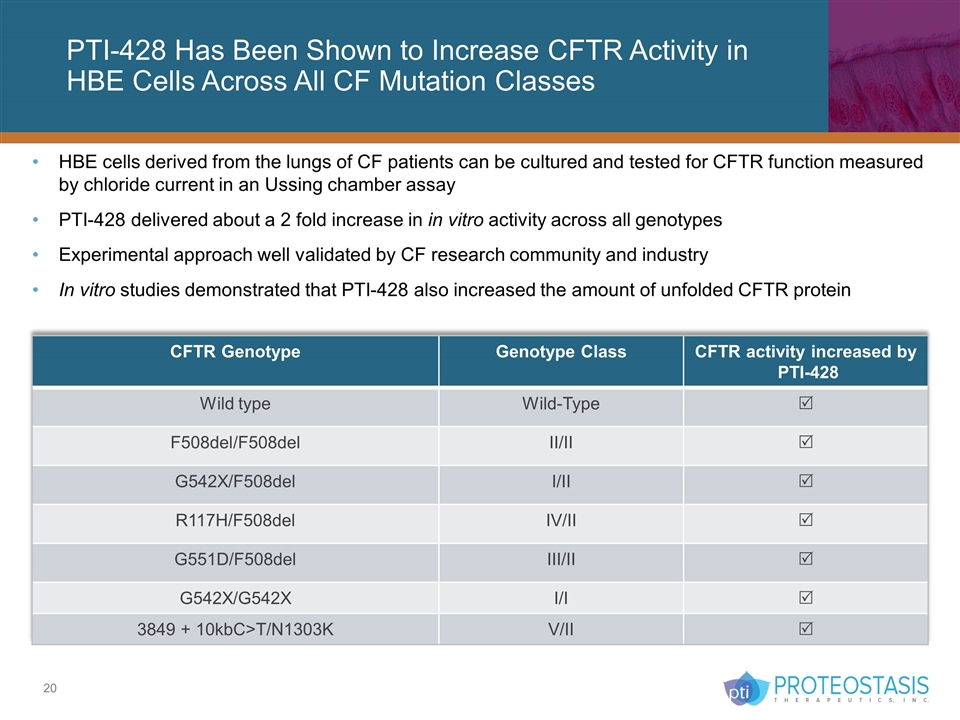
PTI-428 Has Been Shown to Increase CFTR Activity in HBE Cells Across All CF Mutation Classes HBE cells derived from the lungs of CF patients can be cultured and tested for CFTR function measured by chloride current in an Ussing chamber assay PTI-428 delivered about a 2 fold increase in in vitro activity across all genotypes Experimental approach well validated by CF research community and industry In vitro studies demonstrated that PTI-428 also increased the amount of unfolded CFTR protein CFTR Genotype Genotype Class CFTR activity increased by PTI-428 Wild type Wild-Type R F508del/F508del II/II R G542X/F508del I/II R R117H/F508del IV/II R G551D/F508del III/II R G542X/G542X I/I R 3849 + 10kbC>T/N1303K V/II R
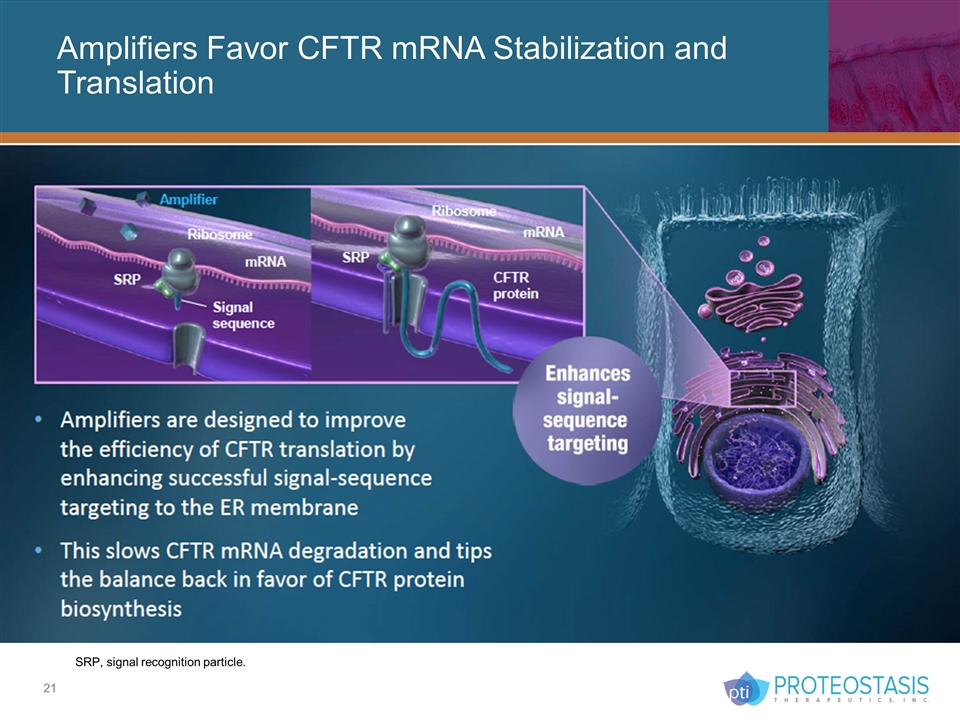
Amplifiers Favor CFTR mRNA Stabilization and Translation SRP, signal recognition particle.
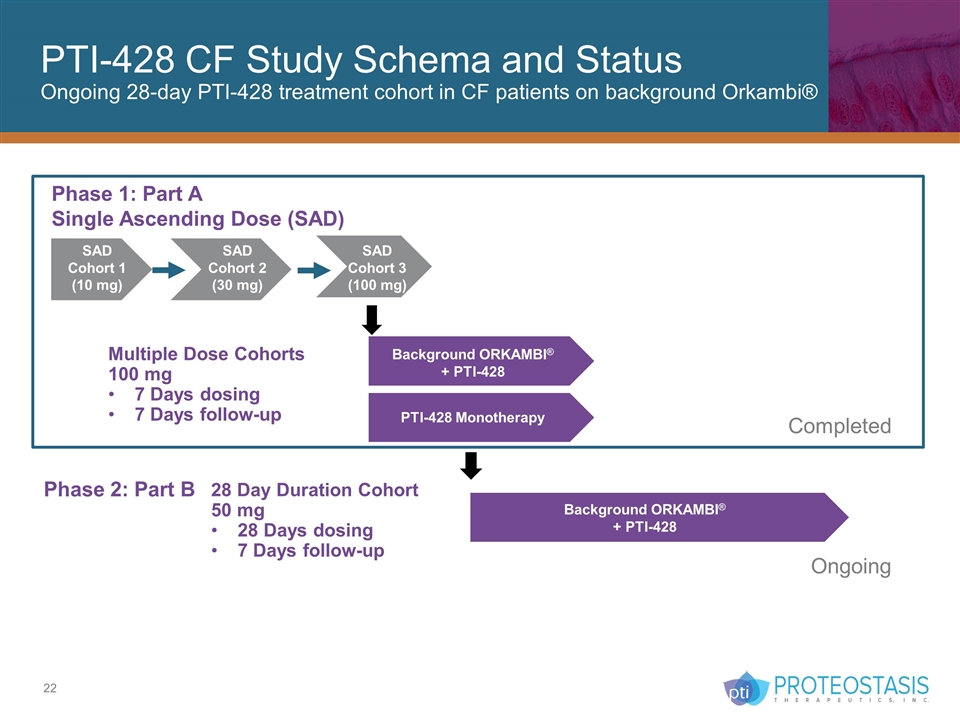
PTI-428 CF Study Schema and Status Ongoing 28-day PTI-428 treatment cohort in CF patients on background Orkambi® Phase 1: Part A Single Ascending Dose (SAD) SAD Cohort 1 (10 mg) SAD Cohort 2 (30 mg) SAD Cohort 3 (100 mg) PTI-428 Monotherapy Multiple Dose Cohorts 100 mg 7 Days dosing 7 Days follow-up Background ORKAMBI® + PTI-428 Background ORKAMBI® + PTI-428 28 Day Duration Cohort 50 mg 28 Days dosing 7 Days follow-up Completed Ongoing Phase 2: Part B
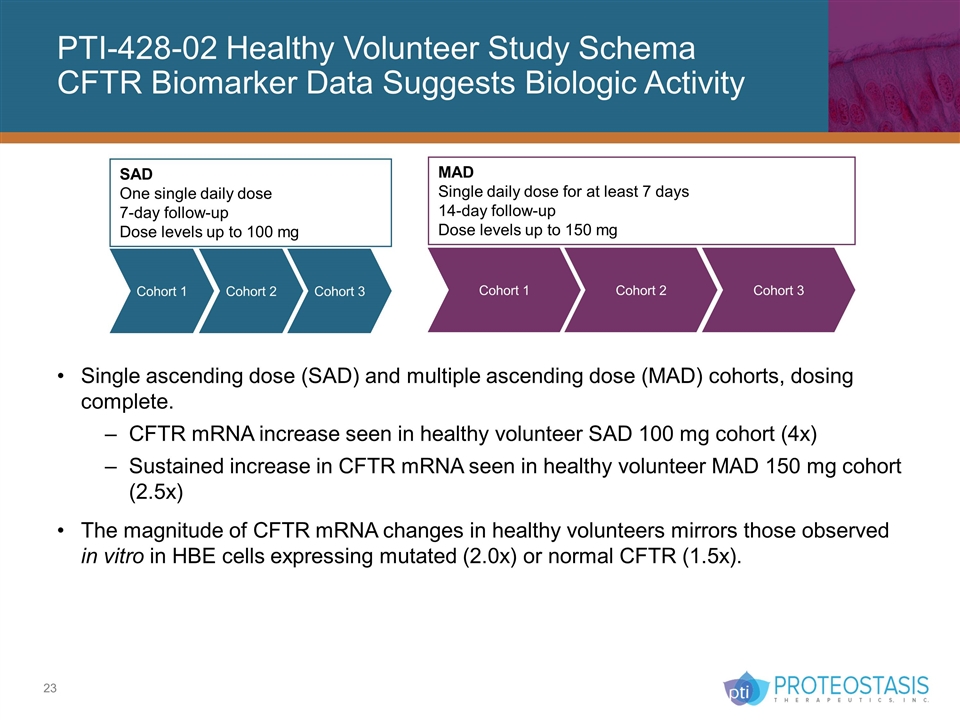
PTI-428-02 Healthy Volunteer Study Schema CFTR Biomarker Data Suggests Biologic Activity Cohort 1 Cohort 2 Cohort 3 Cohort 1 Cohort 2 Cohort 3 SAD One single daily dose 7-day follow-up Dose levels up to 100 mg MAD Single daily dose for at least 7 days 14-day follow-up Dose levels up to 150 mg Single ascending dose (SAD) and multiple ascending dose (MAD) cohorts, dosing complete. CFTR mRNA increase seen in healthy volunteer SAD 100 mg cohort (4x) Sustained increase in CFTR mRNA seen in healthy volunteer MAD 150 mg cohort (2.5x) The magnitude of CFTR mRNA changes in healthy volunteers mirrors those observed in vitro in HBE cells expressing mutated (2.0x) or normal CFTR (1.5x).
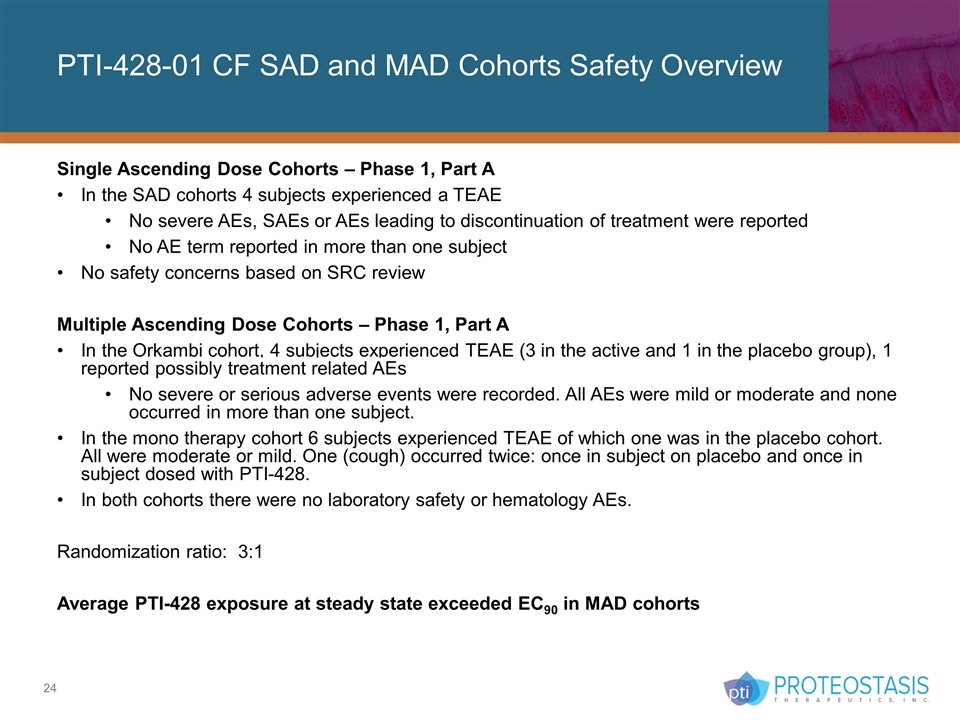
PTI-428-01 CF SAD and MAD Cohorts Safety Overview Single Ascending Dose Cohorts – Phase 1, Part A In the SAD cohorts 4 subjects experienced a TEAE No severe AEs, SAEs or AEs leading to discontinuation of treatment were reported No AE term reported in more than one subject No safety concerns based on SRC review Multiple Ascending Dose Cohorts – Phase 1, Part A In the Orkambi cohort, 4 subjects experienced TEAE (3 in the active and 1 in the placebo group), 1 reported possibly treatment related AEs No severe or serious adverse events were recorded. All AEs were mild or moderate and none occurred in more than one subject. In the mono therapy cohort 6 subjects experienced TEAE of which one was in the placebo cohort. All were moderate or mild. One (cough) occurred twice: once in subject on placebo and once in subject dosed with PTI-428. In both cohorts there were no laboratory safety or hematology AEs. Randomization ratio: 3:1 Average PTI-428 exposure at steady state exceeded EC90 in MAD cohorts
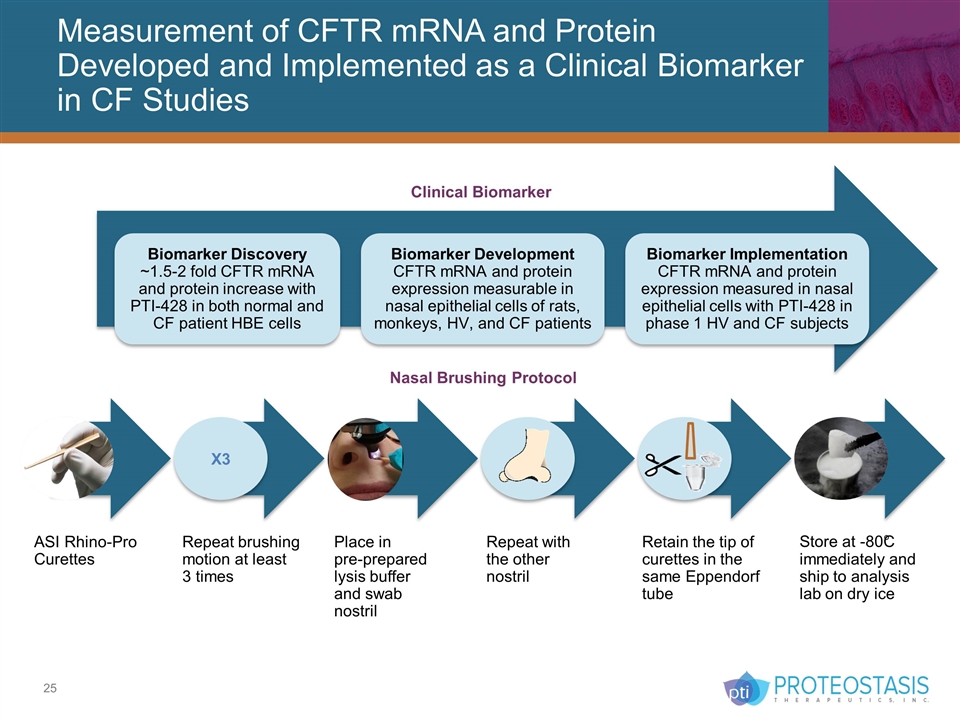
Measurement of CFTR mRNA and Protein Developed and Implemented as a Clinical Biomarker in CF Studies Biomarker Discovery ~1.5-2 fold CFTR mRNA and protein increase with PTI-428 in both normal and CF patient HBE cells Biomarker Development CFTR mRNA and protein expression measurable in nasal epithelial cells of rats, monkeys, HV, and CF patients Biomarker Implementation CFTR mRNA and protein expression measured in nasal epithelial cells with PTI-428 in phase 1 HV and CF subjects Nasal Brushing Protocol Retain the tip of curettes in the same Eppendorf tube Store at -80°C immediately and ship to analysis lab on dry ice Repeat with the other nostril Repeat brushing motion at least 3 times Place in pre-prepared lysis buffer and swab nostril ASI Rhino-Pro Curettes X3 Clinical Biomarker
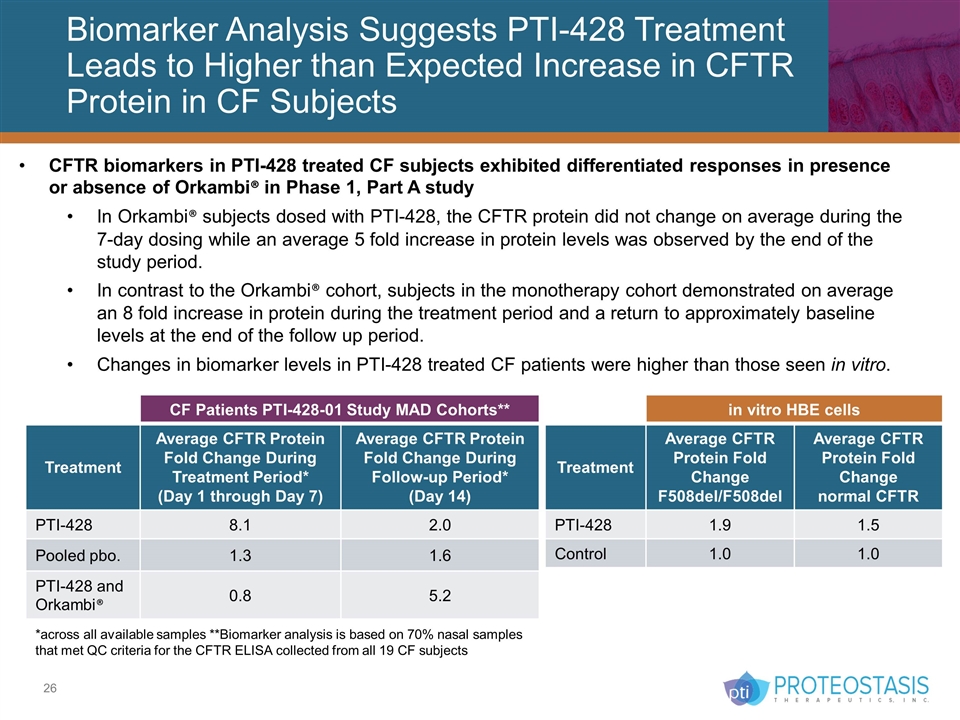
Biomarker Analysis Suggests PTI-428 Treatment Leads to Higher than Expected Increase in CFTR Protein in CF Subjects CF Patients PTI-428-01 Study MAD Cohorts** Treatment Average CFTR Protein Fold Change During Treatment Period* (Day 1 through Day 7) Average CFTR Protein Fold Change During Follow-up Period* (Day 14) PTI-428 8.1 2.0 Pooled pbo. 1.3 1.6 PTI-428 and Orkambi® 0.8 5.2 *across all available samples **Biomarker analysis is based on 70% nasal samples that met QC criteria for the CFTR ELISA collected from all 19 CF subjects in vitro HBE cells Treatment Average CFTR Protein Fold Change F508del/F508del Average CFTR Protein Fold Change normal CFTR PTI-428 1.9 1.5 Control 1.0 1.0 CFTR biomarkers in PTI-428 treated CF subjects exhibited differentiated responses in presence or absence of Orkambi® in Phase 1, Part A study In Orkambi® subjects dosed with PTI-428, the CFTR protein did not change on average during the 7-day dosing while an average 5 fold increase in protein levels was observed by the end of the study period. In contrast to the Orkambi® cohort, subjects in the monotherapy cohort demonstrated on average an 8 fold increase in protein during the treatment period and a return to approximately baseline levels at the end of the follow up period. Changes in biomarker levels in PTI-428 treated CF patients were higher than those seen in vitro.
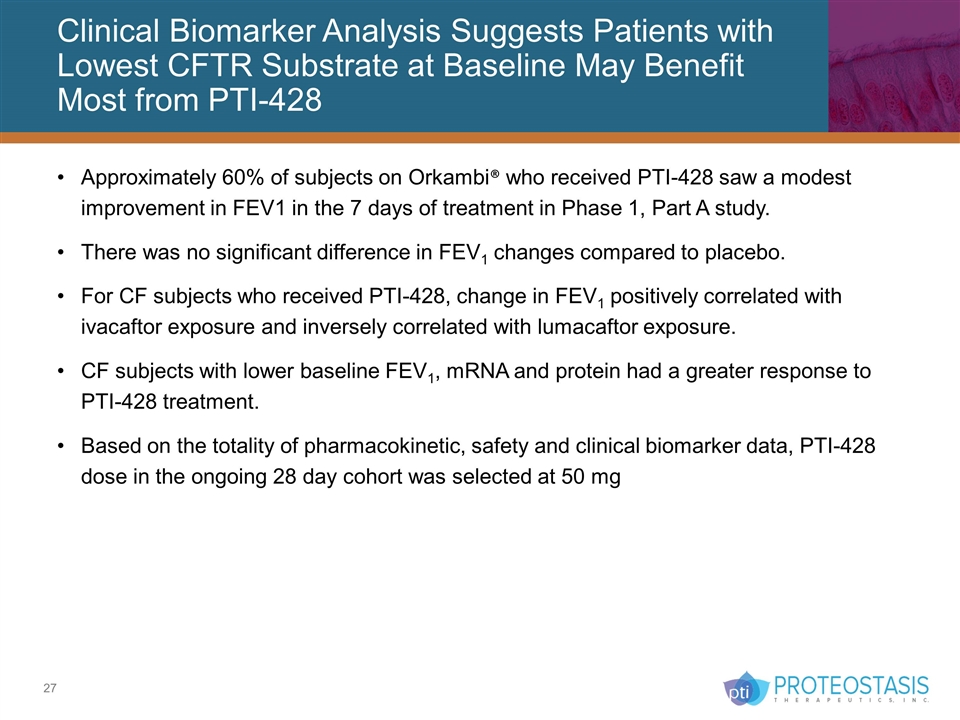
Clinical Biomarker Analysis Suggests Patients with Lowest CFTR Substrate at Baseline May Benefit Most from PTI-428 Approximately 60% of subjects on Orkambi® who received PTI-428 saw a modest improvement in FEV1 in the 7 days of treatment in Phase 1, Part A study. There was no significant difference in FEV1 changes compared to placebo. For CF subjects who received PTI-428, change in FEV1 positively correlated with ivacaftor exposure and inversely correlated with lumacaftor exposure. CF subjects with lower baseline FEV1, mRNA and protein had a greater response to PTI-428 treatment. Based on the totality of pharmacokinetic, safety and clinical biomarker data, PTI-428 dose in the ongoing 28 day cohort was selected at 50 mg
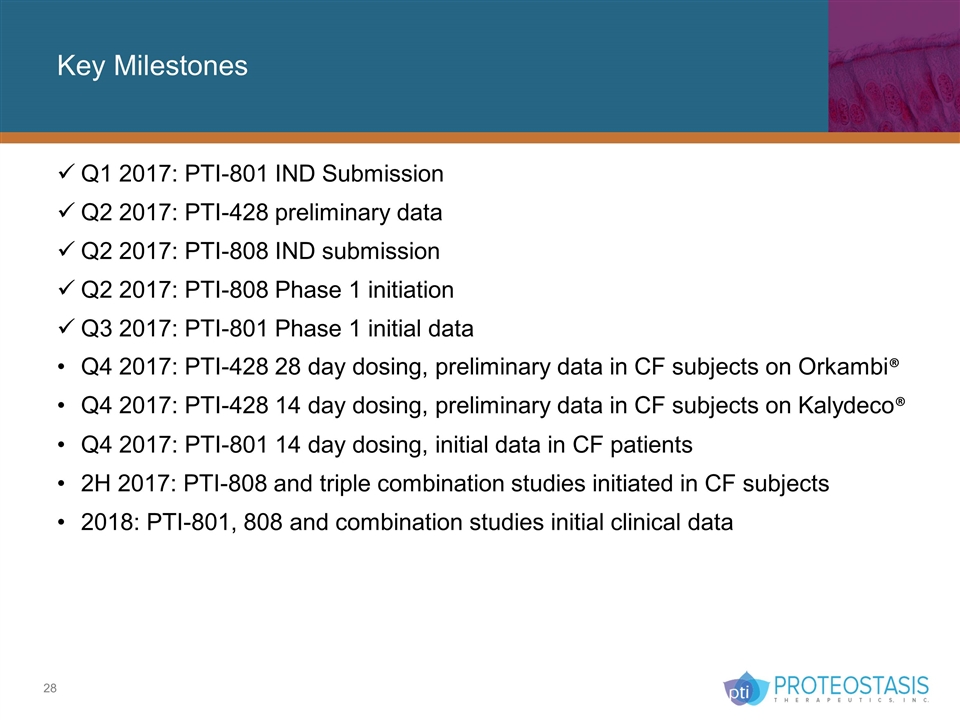
Key Milestones Q1 2017: PTI-801 IND Submission Q2 2017: PTI-428 preliminary data Q2 2017: PTI-808 IND submission Q2 2017: PTI-808 Phase 1 initiation Q3 2017: PTI-801 Phase 1 initial data Q4 2017: PTI-428 28 day dosing, preliminary data in CF subjects on Orkambi® Q4 2017: PTI-428 14 day dosing, preliminary data in CF subjects on Kalydeco® Q4 2017: PTI-801 14 day dosing, initial data in CF patients 2H 2017: PTI-808 and triple combination studies initiated in CF subjects 2018: PTI-801, 808 and combination studies initial clinical data

Thank You




























